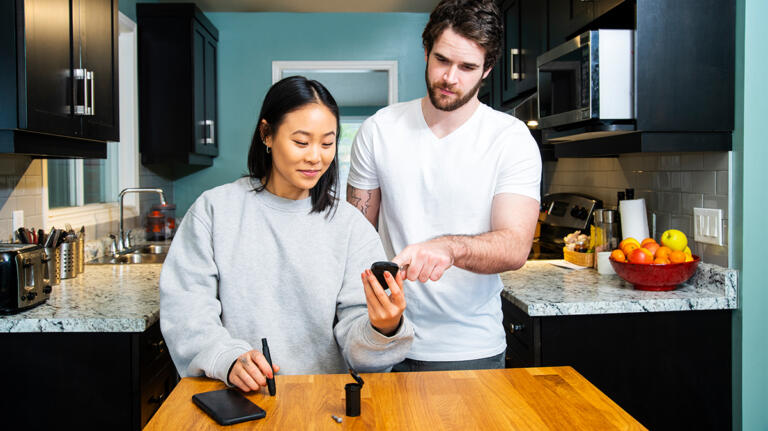
Learn how to navigate prior authorizations, denials, appeals, and applying for an exception.
Everyone living with type 1 diabetes (T1D) should engage in exercise daily. Physical activity is great for your body and has positive effects on your mind.
Managing T1D during and after exercise starts with learning how your glucose levels respond to exercise of different types. By learning more about basic exercise science and the timing of your insulin vs. food and physical activity, you can exercise more safely and reach your fitness goals.
Here’s what you need to know about the type and timing of exercise, insulin-on-board, and fueling your body to keep your blood glucose levels in a safe range during your next workout.

Different types of exercise affect your blood-glucose levels differently. Learning the difference between aerobic versus anaerobic exercise is a must if you live with T1D.
Also known as cardio exercise, aerobic exercise is any activity that you’re performing for an extended period, increasing your heart rate, too. Aerobic exercise uses glucose primarily for fuel, which means it is most likely going to cause hypoglycemia if you have too much insulin active in your body at the time of the exercise.
Also referred to as high-intensity exercise and strength-training, anaerobic exercise is any physical activity that is performed in short bursts, even if your heart rate stays elevated and you’re repeating those bursts of intensity for a long period of time. This type of exercise can raise your blood-glucose levels by converting lactic acid into glucose and using glucose from your muscles for fuel. This means your blood-glucose levels can rise if you don’t take additional insulin during or after your workout.
| Exercise type | Description | Effects on blood-glucose |
|---|---|---|
| Aerobic | Lower intensity, longer duration | Expect a drop in blood-glucose levels |
| Anaerobic | Higher intensity, shorter duration | Expect spikes in blood-glucose levels |
| Mixed | Combination of aerobic and anaerobic activity | Expect blood-glucose levels to fluctuate—can drop or spike |
Also known as “IOB,” this refers to how much insulin is active in your body during and after exercise. Too much insulin during aerobic exercise can lead to low blood sugar. Too little during anaerobic exercise can lead to high blood sugar.
Remember, most of today’s rapid-acting insulin is active in your body for about 4 to 5 hours, with the peak at around 1.5 hours. This means you’ll need to be aware of IOB before, during, and after exercise. Too much IOB means you may need to ingest fast-acting carbohydrates before, during, or after exercise to treat or prevent low blood sugars. Many experts advise exercising at least two hours after your last insulin dose to reduce the risk of low blood-sugar.
Exercising with type 1 diabetes requires you to plan ahead. People using pumps can set temporary basal rates to quickly reduce IOB in anticipation of exercise. Learning how much of a reduction your body needs depends greatly on the intensity, type, and duration of your workout, with support from your healthcare team.
For people taking long-acting insulin, this dose cannot be easily adjusted before a workout. However, long-acting insulin can be adjusted the night after exercise to reduce risk of overnight lows. Work with your healthcare team to ensure your daily dose is generally accurate for your body’s needs.
Now that you understand IOB, you’ll want to consider the timing of your exercise. Ideally, you’re not exercising when you have a full dose of insulin on board.
The timing of your exercise can also affect your blood-glucose levels many hours later. If you’re starting a new workout routine, don’t be surprised if your insulin doses throughout the entire day need to be adjusted with support from your healthcare team.
Exercise can also boost your insulin sensitivity for up to eight hours after a workout—even when you might be sleeping! This is great for your metabolism and long-term health. However, it can result in low blood-glucose levels if you don’t make thoughtful adjustments to your insulin doses.
If you choose to exercise after eating, the foods you eat can help simplify diabetes management. Experts usually recommend a combination of carbohydrates and fat before exercise. Choosing the same snacks can help you plan your diabetes management for that workout.
Exercising with type 1 diabetes involves a lot of trial and error while juggling insulin-on-board, timing, and the type of exercise. Take good notes, keep fast-acting glucose or glucagon with you in case of hypoglycemia, and use a CGM with “Urgent Low Soon” alert enabled, or check your blood-glucose levels often!

Learn how to navigate prior authorizations, denials, appeals, and applying for an exception.

Resources to help you manage the stress and emotions of living with T1D.

Guidance on supporting your loved ones with T1D.